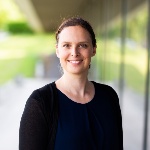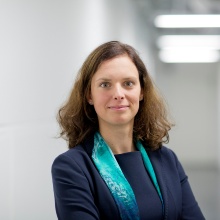Cloud computing without security risks? This vision could become a reality by amalgamating quantum computers and quantum technology processes to encrypt data. This is just one of the research fields that Stefanie Barz is involved in. She has been leading the “Integrated Quantum Optics” research group at the Institute for Functional Matter and Quantum Technologies since April 1.
If asked why she chose to come to Stuttgart Stefanie Barz immediately answers “because I wanted to develop my own research group here”. Originally from Rhineland-Palatinate, she completed her doctoral degree in Vienna and has also recently worked as a researcher in Oxford. Put simply, this research group creates light particles (photons), ‘plays’ with and measures them, with the aim of demonstrating applications in the field of quantum information. For example, such applications might be small quantum computers, quantum simulators and quantum networks. “We want to demonstrate that some things could be done better by applying quantum physics instead of using conventional computers”, says Barz. By ‘better’ she means primarily: faster and more secure.
With this goal in mind, the scientist wants to amalgamate two important areas of application in the field of quantum physics: firstly, the concept of quantum computers, which display information in quantum bits rather than bits, these are capable of using not just the values 0 and 1, but also superpositions of these states. It is hoped that such systems could, for example, offer a much more efficient solution than classic computers for searching in huge data bases and breaking down large numbers. The second application is quantum cryptography, which can encrypt data securely. “We are searching for ways, not only to process data quickly, or to send it securely from A to B, but to process it both faster and more securely”, explains Barz. This might sound very practical, but it is very basic research. “We develop new concepts and demonstrate these in our laboratory.”
Release of the First Secure Computation
Barz, together with her colleagues in Vienna and other international partners, proved that this is possible with a series of experiments that drew a great deal of attention when they were published during her doctoral studies in Science and Nature Physics. They demonstrated for the first time how a user can release a completely secure computation. In this case secure means that unauthorized persons are unable to reconstruct information from the released data about the type of data query or the computing operations used to carry out the computation. This is possible because the computer computes, but does not know what it is computing.
The next step involves expanding the scope of the experiments to include an entire network of users and quantum computers. Just like with a classic cloud, the elements in a quantum cloud can communicate with each other and work together to compute applications – without revealing information about each other.
The group also works on quantum simulations that are intended to aid a better understanding of the characteristics of complex systems. To do this, the scientists are constructing a mini model from individual quantum particles so that they can carry out measurements. The aim is to understand the mini model well enough that this knowledge can then be applied to the construction of a complex system.
Extremely Interdisciplinary
An interdisciplinary and international approach are key to successfully making the leap from quantum physics to developing applications. Barz has always worked closely with colleagues in the fields of computer science and mathematics from all over the world. In Stuttgart, engineers are being introduced to this mix, which is why the research group is not only based in the institute offices in the physics department, but also has rooms in the electrical engineering department.
“Working together with engineers introduces a whole new perspective”, explains Barz. One example of this is the huge experimentation tables with numerous optical elements, a basic tool required for quantum optical experiments. Lasers and single protons are guided through mirrors, lenses, crystals and various other instruments. In terms of research, it is important to minimize the experimental facilities and save the elements on a chip. But how can one guide the laser beam or design the chip? “When solving such issues, it is great to be able to use engineering knowledge.”
Building Bridges
One of the challenges of such an interdisciplinary approach, is that the various disciplines do not all speak the same language. This begins with the term ‘quantum technology’: “Physicists understand this as something new that can result in an application, engineers want to produce something useful”, says Barz with a wink. The different cultures are reflected even in discussions about future research topics: “For us physicists, it is not only super-new applications of quantum effects that are interesting, but also the pure basics of quantum physics. For engineers, it is important to develop a new chip or device.”
But the different languages and ideas also bring about new opportunities, emphasizes the physicist: “It leads to new questions”, and to a mutual learning process. “We want to build a bridge between quantum physics and engineering sciences and understand each other simultaneously as translators communicating between and within theoretical computer science and practical engineers.”
Further information can be found on the institute’s website – one of the first to use the new corporate design. https://www.fmq.uni-stuttgart.de/en/

Stefanie Barz
Prof. Dr.Professor: Quantum Information & Technology



